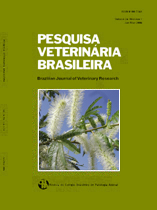 |
|
|
|
Year 2010 - Volume 30, Number 10
|

|
Development of a dog model of hemodialysis, 30(10):861-867
|
ABSTRACT.- Meneses A.M.C., Caramori J.C.T., Brant J.R.A.C., Gonçalves R.C., Souza N.F., Moraes C.C.G., Takahira R.K. & Barretti P. 2010. [Development of a dog model of hemodialysis.] Desenvolvimento de um modelo experimental de hemodiálise em cães. Pesquisa Veterinária Brasileira 30(10):861-867. Instituto da Saúde e Produção Animal, Universidade Federal Rural da Amazônia, Av. Presidente Tancredo Neves 2501, Montese, Cx. Postal 917, Belém, PA 66077-530, Brazil. E-mail: andre.meneses@ufra.edu.br
To develop a model of hemodialysis (HD), 18 healthy dogs, without a defined breed, males, weighing 7-14 kg, were studied. A double lumen catheter was inserted into the jugular vein for vascular access. HD sessions, totalizing 5 for each dog, were performed with a proportional HD machine, controlled isovolemic ultrafiltration, standard dialysis solution and bicarbonate buffer. Sodium profile and sodium heparin were used. During HD sessions the dogs were kept anesthetized (levomepromazine and propofol). Hematological and biochemistry data, blood gas analysis, systemic arterial blood pressure, and activated clotting time were evaluated. Serum biochemistry e blood gas analysis showed, respectively, sodium and SO2 maintenance. Systemic blood pressure kept sustained during HD sessions. It could be concluded that it was possible to develop a HD dog model that is a safe and viable technique to be used in chronic renal failure patients. |
| |
|
|
| |
|
 |